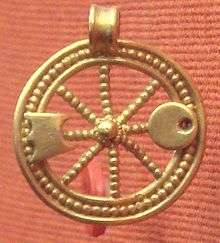Icovellauna
Icovellauna was a Celtic goddess worshiped in Gaul. Her places of worship included an octagonal temple at Le Sablon in Metz, originally built over a spring,[1] from which five inscriptions dedicated to her have been recovered,[2] and Trier, where Icovellauna was honored in an inscription in the Altbachtal temple complex.[3][4][A] Both of these places lie in the valley of the Moselle river of eastern Gaul in what are now Lorraine in France and Rhineland-Palatinate in Germany. One such inscription was, somewhat unusually, inscribed on a copper tablet in Roman cursive letters.[5]
At the temple in Metz, a spiral staircase led down to the water level, allowing worshipers to leave offerings in the spring and/or to take the waters. A statuette of a local Gaulish Mercury was among the ex-votos deposited at the shrine,[1][6] which also included coins and ceramics dating from the 2nd to 4th centuries CE.[7] Jeanne-Marie Demarolle states that Apollo was also associated with Icovellauna.[8]
Demarolle glosses the name Icovellauna as bonne fontaine or "good fountain".[9] Miranda Green follows Joseph Vendryes in interpreting the Gaulish root ico- as "water" and characterizes Icovellauna as a "water goddess" who "presided over the nymphaeum at Sablon in the Moselle Basin, a thermal spring-site".[10] Xavier Delamarre, however, considers Vendryes' interpretation to be very improbable; on purely etymological grounds, he suggests that ico- might be the name of a bird, perhaps the woodpecker.[11] The root uellauno- has been variously interpreted, though the interpretation "chief, commander" has recently found favor;[12] see Vellaunus.
Notes
^ A: Although Jufer and Luginbühl also report a number of inscriptions to Icovellauna at Malzéville,[13] it has been suggested that this is an error on their part and that the inscriptions in question belong at Le Sablon in Metz.[14] The Epigraphik-Datenbank Clauss/Slaby has no records of any inscriptions from Malzéville published in CIL or similar publications.[15]
References
- Dyfed Lloyd Evans (2005). "Icovellauna: a Gaulish Goddess (Divine Pourer of the Waters) Archived 2006-08-27 at the Wayback Machine" from www.celtnet.org.uk Archived 2006-08-29 at the Wayback Machine, accessed 10 September 2006.
- CIL XIII, 4294-4298. Of these, only CIL 13: 4294 is complete.
- CIL XIII, 3644
- Edith Mary Wightman (1970). Roman Trier and the Treveri. Rupert Hart-Davis, London, p.217.
- Demarolle (1992), p. 23.
- Le Sablon › L'histoire › Période gallo-romaine. Includes a line drawing of Icovellauna's sacred well in Metz. Retrieved on 2010-02-27.
- Demarolle (1992), p. 29.
- Demarolle (1992), p. 26.
- Demarolle (1992), p. 27.
- Miranda Green (1986). The Gods of the Celts. Alan Sutton, Gloucs. ISBN 0-389-20672-5. pp.85, 165.
- Delamarre (2003), p. 187.
- Delamarre (2003), p. 310.
- Nicole Jufer & Thierry Luginbühl (2001). Les dieux gaulois : répertoire des noms de divinités celtiques connus par l'épigraphie, les textes antiques et la toponymie. Editions Errance, Paris. ISBN 2-87772-200-7. p.45; pp.50,70.
- Scrupulum (2007-03-19). Icovellauna: la bonne eau ou la grande Victoire? (in French) Retrieved on 2010-02-27.
- Epigraphik-Datenbank Clauss/Slaby. Archived 2010-03-25 at the Wayback Machine Retrieved on 2010-02-27.
Works cited
- Delamarre, Xavier (2003). Dictionnaire de la langue gauloise : Une approche linguistique du vieux-celtique continental (in French) (2nd ed.). Éditions Errance. ISBN 2-87772-237-6.CS1 maint: ref=harv (link)
- Demarolle, Jeanne-Marie (1992). "Les eaux et le sacré dans la Lorraine antique". Dossiers d'Archéologie (in French). 173-177 (174): 22–32. L'eau en Gaule, rites sacrés et thermalisme.CS1 maint: ref=harv (link)

